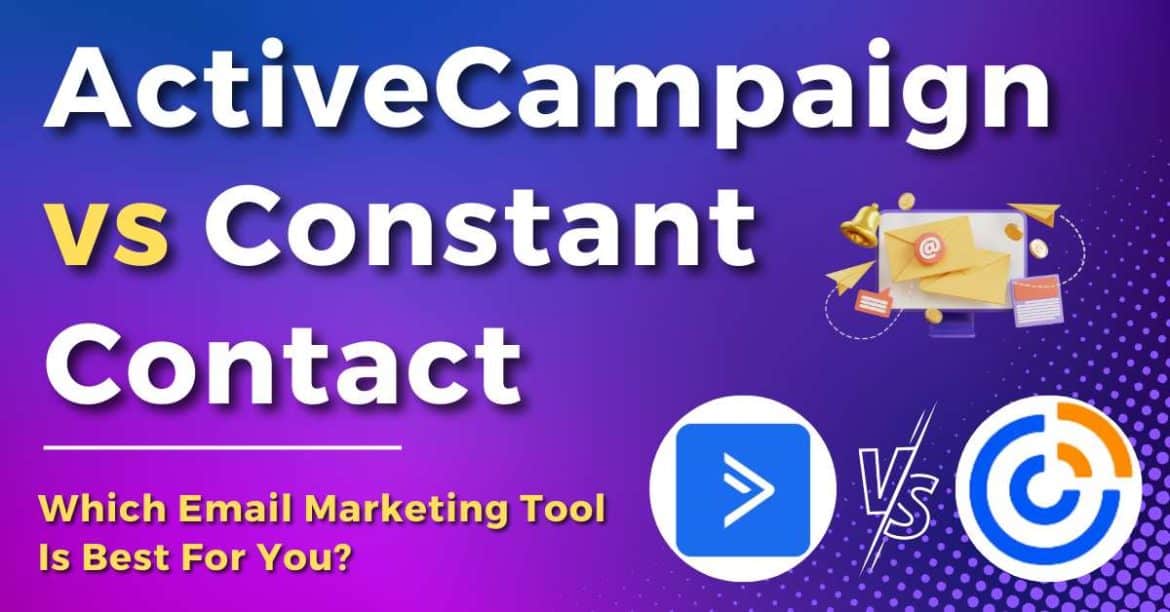ActiveCampaign vs Constant Contact – which should you choose?
Picking the right email marketing and automation platform is crucial in order to build your brand and maintain effective communication with your customers.
Whether you’re completely new to email marketing or looking to shake up your email marketing game, we have you covered.
In this ActiveCampaign vs Constant Contact guide, I’ll dive into everything each platform brings to the table to find out which is best for you!
Read more: Top 5 Best FREE Email Marketing Software For Small Business.
ActiveCampaign vs Constant Contact 2024
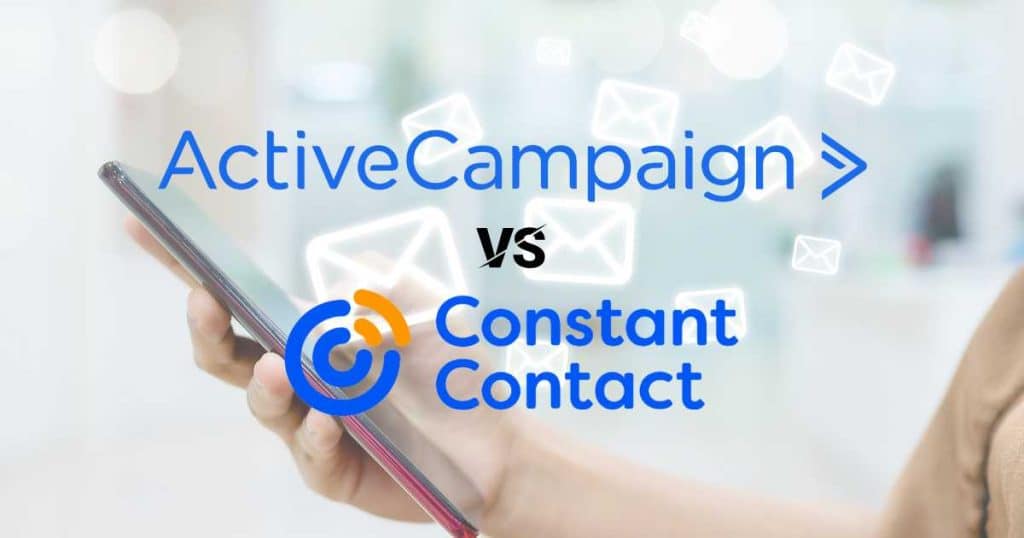
I’m sure you’ve heard of ActiveCampaign, an absolute powerhouse for email marketing and sales automation.
And while Constant Contact offers the essential tools required for running email marketing campaigns, it misses certain useful features.
But does that mean it’s a bad choice for small businesses? Not necessarily….
Both tools have different approaches regarding ease of use, pricing, and features.
My goal is to jump into all of that and more to determine which is the best fit for you and your business!
Are you ready to take your email marketing to the next level? Let’s go!
What Are They? ActiveCampaign vs Constant Contact
ActiveCampaign stands out for its robust automation and advanced CRM (customer relationship management) functionality.
It offers a comprehensive set of sales and marketing tools to help you create complex automation workflows and personalized customer journeys.
With its intuitive interface and powerful segmentation options, ActiveCampaign allows you to deliver highly targeted and personalized email campaigns to your audience!
On the other hand, Constant Contact is one of the oldest email marketing platforms on the web (almost 3 decades old!)
Constant Contact is known for being a solid foundation for beginners or small business owners looking to start and drive their email marketing initiatives.
Constant Contact offers a range of pre-designed templates, a drag-and-drop editor, built-in CRM, and list management features to simplify email marketing.
What Are The Differences between ActiveCampaign vs Constant Contact?
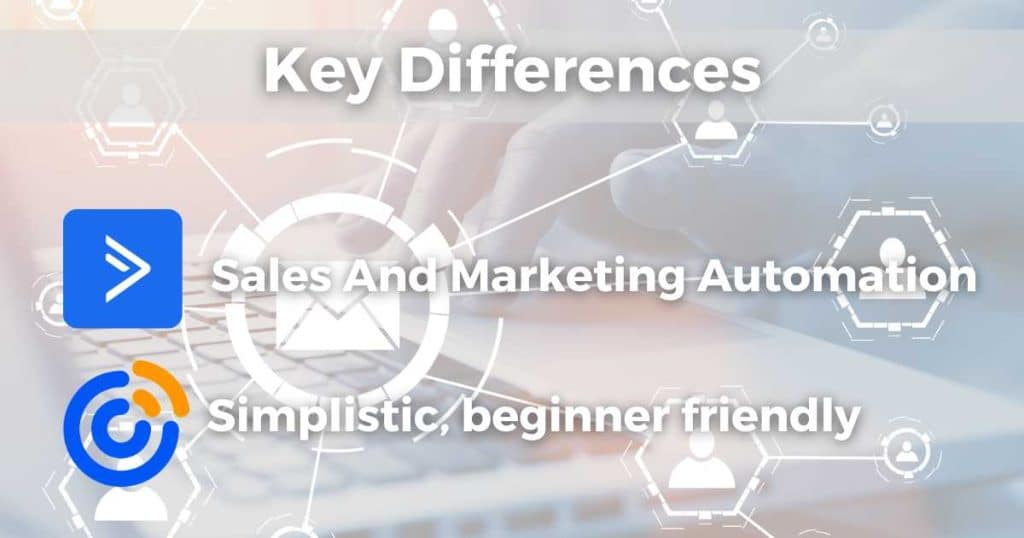
There are many similarities between ActiveCampaign and Constant Contact, but there are also some key differences in the functionality and flexibility of each platform.
As mentioned, ActiveCampaign is known for its advanced automation and CRM features.
While Constant Contact offers automation and CRM capabilities, they’re less advanced than ActiveCampaign’s.
Additionally, ActiveCampaign offers more features and greater flexibility, whereas Constant Contact focuses on simplicity and beginner-friendly features.
Choosing between ActiveCampaign and Constant Contact depends on your specific requirements, budget, and level of technical expertise.
It’s safe to say that the two have quite different approaches. So, with that said, let’s dip our toes a little bit deeper into each tool to find out which comes out on top!
Read more: ActiveCampaign vs HubSpot.
Ease Of Use:
ActiveCampaign offers an intuitive user interface with a clean design that centralizes campaign creation and management functions.
Although feature-rich, ActiveCampaign is designed with beginners in mind through their drag-and-drop builders, role-based permissions, and easy workflow capabilities.
Onboarding with ActiveCampaign may be slower, and there may be a steep learning curve to begin with for complete newbies.
However, plenty of free resources like webinars and knowledge bases are available to help.
On the other hand, Constant Contact prioritizes simplicity, and is a match made in heaven for teams just looking to get started!
Its interface and campaign builder focus on essential email marketing tasks, making it ideal for non-technical users. However, it lacks sophisticated capabilities for complex workflow (more on this soon).
Nonetheless, the platform’s pared-down options simplify the email marketing creation process without clutter, which is a big selling point to many users.
And like ActiveCampaign, Constant Contact offers free onboarding support and knowledge bases.
ActiveCampaign provides greater functionality through an intuitive design, albeit with a steeper learning curve.
However, this one has to go to Constant Contact for its simplicity towards core email marketing needs.
Winner = Constant Contact.
Read more: ActiveCampaign vs MailChimp.
Pricing:
Like I said, both tools provide email marketing, automation, and CRM capabilities. So, what do the pricing structures look like?
ActiveCampaign:
ActiveCampaign’s pricing structure is a little complex. But to keep things simple, if you’re just after email automation marketing, go with one of ActiveCampaign’s marketing plans:
- Lite: $29 per month (1000 contacts).
- Plus: $49 per month (1000 contacts).
- Professional: $149 per month (1000 contacts).
- Enterprise: Custom price.
If you need sales engagement and CRM features only, you can opt for one of their Sales plans.
Alternatively, if you’re looking for a robust CRM and email marketing platform, I suggest going with their marketing and sales Bundle plans!
Constant Contact:
Constant Contact’s plans are simpler than ActiveCampaign’s, with just three plan options:
- Lite: $30 per month (1000 contacts).
- Standard: $55 per month (1000 contacts).
- Premium: $110 per month (1000 contacts).
All these plans include built-in marketing CRM and integrations. However, the ‘Lite’ plan excludes automations and segmentation tools.
Considering you have to spend another $20+ to leverage email marketing and sales CRM on ActiveCampaign, Constant Contact is the more affordable option!
Winner = Constant Contact
ActiveCampaign vs Constant Contact Key Features
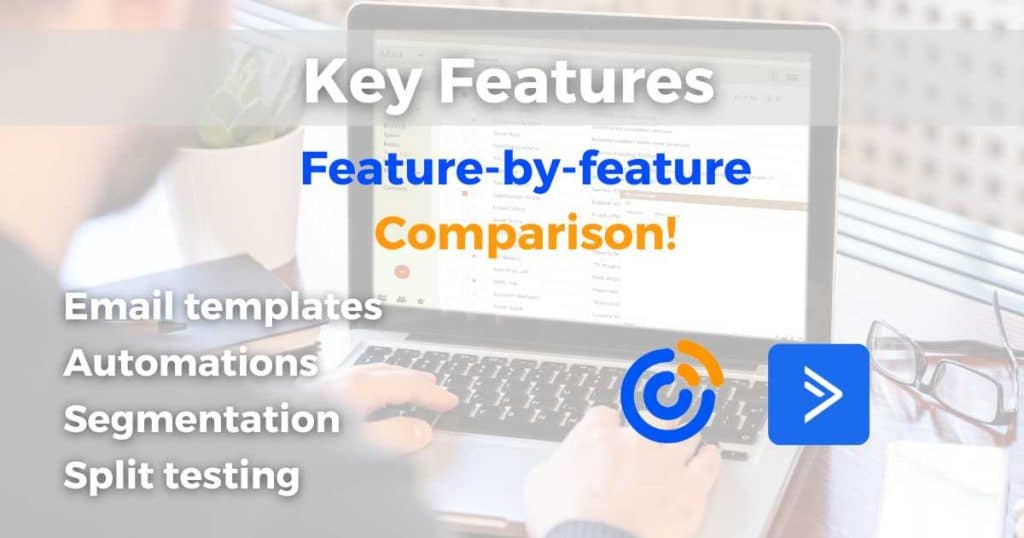
Email Templates and Design:
ActiveCampaign offers hundreds of pre-made stunning email template designs spanning various categories, such as:
- Promotions.
- Newsletters.
- Announcements.
- Holidays, and more.
The templates can be customized to align with your brand, and the intuitive drag-and-drop editor allows you to personalize content blocks, images, colors, and fonts with ease.
With fully mobile-responsive emails that complement your brand style, coupled with dynamic content tags for scalable personalization, ActiveCampaign’s template capabilities are hard to beat.
Similarly, Constant Contact provides hundreds of pre-designed email templates in categories like promotions, newsletters, welcome series, and holidays.
The template editor also allows for easy customization using drag-and-drop content blocks, however, it offers fewer customization options than ActiveCampaign.
But, its not all bad! You can still adjust colors, fonts, and images to match your branding and utilize dynamic tags for personalization.
If you’re seeking ready-to-use newsletter templates and don’t want to muck around with customization too much, Constant Contact is a reliable choice.
However, ActiveCampaign is the superior option for people who want more control over how their designs look (without the hassle of learning any code).
With a wider selection of templates, easier editing capabilities, and more personalized tags, ActiveCampaign is the top choice for teams looking to create beautiful templates tailored to their business.
Winner = ActiveCampaign.
Read more: MailerLite vs ActiveCampaign.
Segmentation:
Let’s talk about segmentation!
ActiveCampaign takes segmentation seriously, with its machine learning advanced subscriber segmentation tools.
These built-in segmentation tools allow you to group your contacts based on:
- Demographics.
- Interests.
- Behaviors.
- Engagement metrics.
- Purchase history, and more.
This level of granularity allows you to target segments or Facebook Lead Ads with tailored content blocks, personalized subject lines, and automated workflows.
Additionally, ActiveCampaign provides intelligent lists that automatically update in real-time based on user activity.
This feature allows you to create dynamic groups such as high-intent leads, abandoned cart shoppers, or loyalty program members.
In comparison, Constant Contact provides basic segmentation capabilities, allowing you to target groups using user attributes and tags.
While you can target segments based on location, interests, and purchase history, Constant Contact lacks robust behavioral targeting and real-time user activity tracking.
You can send broadcasts (emails) to list segments, but it lacks the capabilities required for tailoring content and triggering personalized workflows based on subgroup characteristics.
If you’re looking for straightforward grouping without complex segmentation logic, Constant Contact provides the basics.
However, for advanced subscriber targeting and sophisticated functionality, ActiveCampaign outshines the competition with its flexible contact segmentation tools!
Winner = ActiveCampaign.
Read more: ClickFunnels vs ActiveCampaign.
Automation:
ActiveCampaign is the unrivaled leader in automation, offering a wealth of easy-to-use-built templates and triggers.
With an intuitive visual workflow builder, you can effortlessly create sequences for welcome series, lead nurturing, cart abandonment, and more without knowing an ounce of code!
What sets ActiveCampaign apart is its blending machine learning and AI technology.
This empowers you to work smarter, not harder to segment contacts, personalize messaging, and respond to behaviors in real-time event-based triggers based on data.
Additionally, ActiveCampaign offers smart lists, customized user segments, and seamless email marketing, CRM and SMS automations for full-funnel visibility.
In contrast, Constant Contact takes a simpler approach to email automation, supplying 50+ pre-made email templates to engage website visitors and convert them into leads.
While it allows for basic triggers like:
- First purchase.
- Welcome Emails.
- Lead nuturing sequences.
- Abandoned cart.
- And date-based sequences.
It lacks the advanced segmentation capabilities and dynamic content personalization of ActiveCampaign.
You can set up multi-step triggers but with limitations.
In my opinion, Constant Contact can’t compete with the flexiblity and complexity that ActiveCampaign offers.
Therefore, when it comes to marketing automation workflows, ActiveCampaign clearly takes the crown!
Winner = ActiveCampaign.
Read more: ActiveCampaign vs Drip
Split Testing:
Split testing (A/B testing) involves sending different versions of an email campaign to segments of your mailing list to determine which performs the best.
The advantage of A/B testing cannot be overstated! It allows you to explore different marketing strategies and gain insights into what resonates with various demographics.
ActiveCampaign stands out in the realm of A/B testing by allowing you to test up to a whopping five different versions of your email at the same time.
This is a higher number than what you’ll typically find elsewhere!
Additionally, you can experiment with different subject lines, email content, overall design, and more, which is pretty cool.
On the other hand, with Constant Contact’s cheaper plans, you can’t set up A/B testing. And even if you upgrade to a more expensive plan, you can only split test subject lines.
This means that no matter how much you invest, you’ll never be able to test media, content, or design like you can with ActiveCampaign!
Winner = ActiveCampaign.
Read more: ActiveCampaign vs tinyEmail.
ActiveCampaign vs Constant Contact Stand Out Features:

Okay, so we’ve compared both tools feature-by-feature. But are there any standout features that set them apart?
ActiveCampaign:
ActiveCampaign stands out among other email marketing platforms due to its unique capabilities:
- Site tracking: ActiveCampaign integrates web analytics with email performance to comprehensively view subscriber engagement. By capturing every touchpoint across channels in one place, you can gain unique and valuable insights into your customers.
- Predictive content blocks: Powered by AI, ActiveCampaign’s predictive content blocks allow your customers to receive personalized, relevant, and dynamic messages!
- Integrated event triggering: ActiveCampaign enables real-time reactions to customer behaviors and workflows through seamless integration with webinars, eCommerce platforms, and other SaaS solutions. This allows marketers to respond swiftly and effectively to customer actions, enhancing customer experience.
With the help of ActiveCampaign’s unique capabilities, you can transform strangers into loyal customers over time by delivering personalized, tailored journeys!
Constant Contact
Constant Contact zeroes in on core email marketing execution, offering features to simplify campaign creation.
For instance, its users can create email content directly within the platform without requiring separate design software, engage in split testing, and robust reporting tracking.
Constant Contact also offers creative tools to build social media posts for various channels, including Facebook, LinkedIn, and Instagram, and offers dynamic SMS marketing tools to capture a wider audience.
However, compared to ActiveCampaign, the platform lacks specific innovative capabilities such as comprehensive automation, predictive content, and cross-channel intelligence.
Instead, its unique features focus on basic email functionality rather than data-driven customer engagement.
Active Campaign vs Constant Contact Integrations:
ActiveCampaign offers 250+ integrations with native connectors and APIs, connecting with popular eCommerce platforms, CRM tools, webinar software, and more.
Popular integrations include Shopify, WordPress, Zapier, Eventbrite, and Stripe.
Constant Contact integrates with accounting, eCommerce, and CRM systems but lags behind ActiveCampaign in ecosystem strength.
Its integrations include Shopify, Eventbrite, Facebook, and PayPal.
However, they focus on moving data into Constant Contact rather than enabling cross-platform workflows.
Winner = ActiveCampaign.
ActiveCampaign vs Constant Contact Customer Support
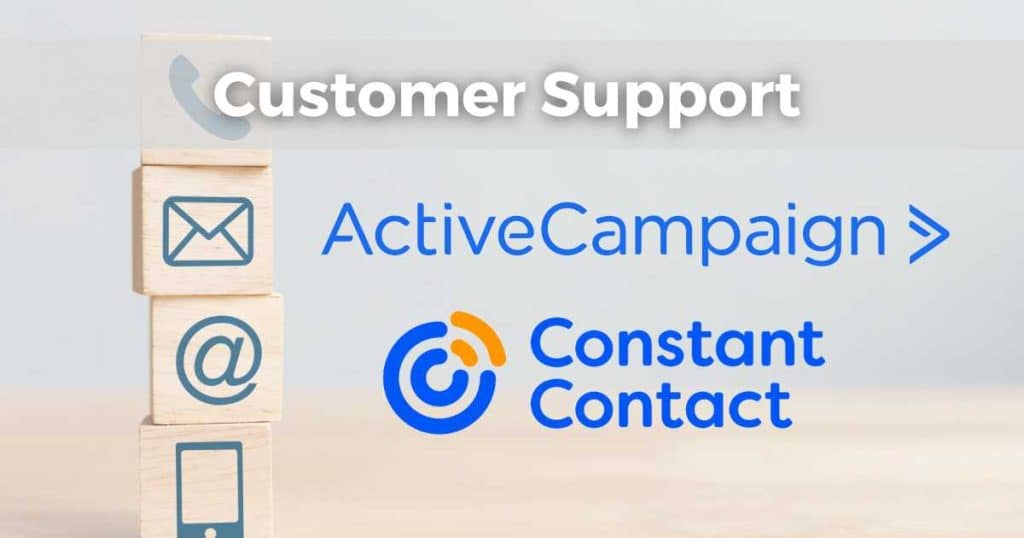
ActiveCampaign goes above and beyond to provide exceptional customer support.
With 24/7 live chat and email support from dedicated account strategists, assistance is just a message away.
Phone support is also available during extended business hours, ensuring prompt resolutions. In fact, typical ticket response times are under 30 minutes.
ActiveCampaign also offers a helpful knowledge base, YouTube channel, and Facebook group with over 100,000 users.
Constant Contact also offers 24/7 email and chat support (with response times of under 1 hour) and phone assistance available during East Coast business hours.
While their online knowledge base contains thousands of articles, the level of personalization isn’t quite up to scratch compared to ActiveCampaign.
Larger customers receive dedicated strategists, while smaller accounts receive generalized support reps, potentially hindering the quality of individual guidance for growing businesses.
They, too, have a Facebook Page, but the page has limited discussions.
Winner = ActiveCampaign
ActiveCampaign vs Constant Contact Which Is Best For You?

If you’re a growing business looking for a complex and powerful email marketing, advanced automation, and CRM platform, there’s no doubt that ActiveCampaign is best for you.
ActiveCampaign enables mid-market and startup brands to achieve enterprise-level functionality and scalability beyond basic email campaigns.
Choose ActiveCampaign for an intuitive, flexible, comprehensive platform that optimizes customer journeys!
However, this doesn’t necessarily mean that ActiveCampaign is the better choice for you.
Constant Contact is a solid choice if you’re a brand-new startup and want to simply send email newsletters with simplified options.
With quality templates, simple subscriber management, and basic deliverability, Constant Contact is suitable for businesses with 5000 contacts or less.
If you’re a nonprofit, creative, or blogger and prioritize quick implementation without the need for extensive functionality, chances are you’ll love Constant Contact!
With its affordable pricing, Constant Contact is great for micro-businesses prioritizing brand awareness and community-building through email communications.
My Final Thoughts
And that’s it! I’ve now covered everything there is to know about ActiveCampaign vs Constant Contact.
I hope you can now confidently choose the best option for you and your brand.
So, what will you be choosing? ActiveCampaign vs Constant Contact?
Let me know what you end up going with!
